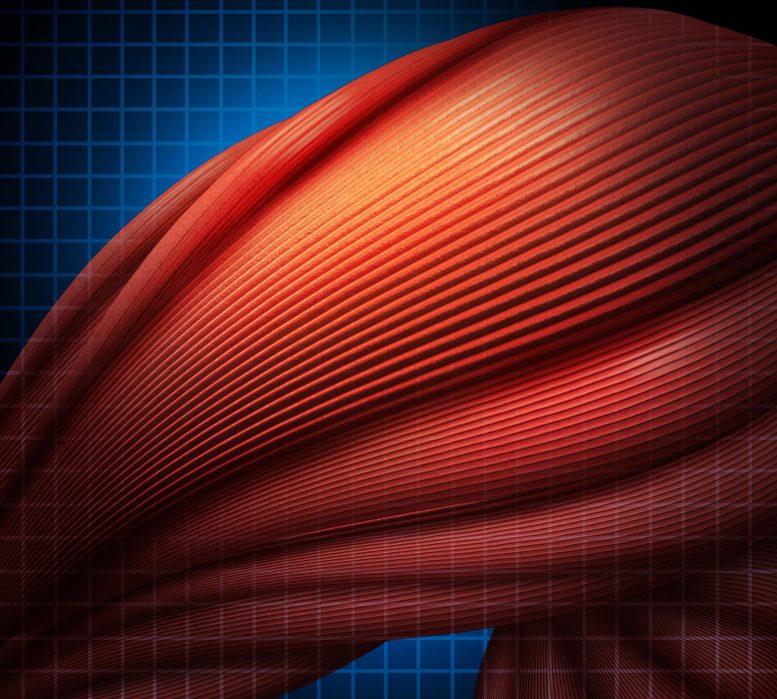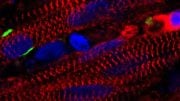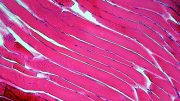
Glucocorticoid steroids improved muscle performance through distinct, sex-specific molecular mechanisms in mice, according to a Northwestern Medicine study published in the Journal of Clinical Investigation (JCI).
“This work highlights the importance of studying both sexes and uncovering two complementary pathways,” said Elizabeth McNally, MD, PhD, the Elizabeth J. Ward Professor of Genetic Medicine, director of the Center for Genetic Medicine and senior author of the study.
Isabella Salamone, a graduate student in the Driskill Graduate Program in Life Sciences (DGP), was lead author of the study.

Elizabeth McNally, MD, PhD, the Elizabeth J. Ward Professor of Genetic Medicine and director of the Center for Genetic Medicine, was the senior author of recent studies published in the Journal of Clinical Investigation and Science Advances. Credit: Northwestern University
Glucocorticoids are naturally occurring stress hormones that peak in early morning, just before waking. When taken as drugs and in high doses, glucocorticoids bind to cell’s glucocorticoid receptors to regulate gene expression for anti-inflammatory proteins. However, when used chronically, glucocorticoids steroids can cause adverse effects like insulin resistance and muscle wasting or atrophy.
Patients with Duchenne muscular dystrophy, a genetic disorder that causes progressive muscle weakness, are prescribed glucocorticoids steroid to improve muscle strength. Long-term glucocorticoid use has been problematic since it can lead to many side effects like obesity and osteoporosis, according to McNally.
“It has always been a paradox that steroids are used in Duchenne muscular dystrophy, since in some medical settings patients develop muscle weakness after taking these steroids,” said McNally, who is also a professor of Medicine in the Division of Cardiology and of Biochemistry and Molecular Genetics.
When administered in short doses, some studies have shown enhanced muscle performance after taking brief pulses of glucocorticoid steroids, but the molecular mechanisms behind this remained understudied.
In a previous study published in JCI that was also led by McNally, her team found that administering the glucocorticoid steroid prednisone just once a week in mice improved muscle recovery after injury and repaired muscles damaged by muscular dystrophy without adverse side effects.
“Steroids like prednisone can increase ‘atrophy’ factors, proteins that mediate muscle wasting. What we found was that once weekly prednisone did not cause the atrogenes to go up, so we could get the benefit without the atrophy,” McNally said.

Isabella Salamone, a graduate student in the Driskill Graduate Program in Life Sciences (DGP), was lead author of the study published in the Journal of Clinical Investigation. Credit: Northwestern University
Muscle tissue is sexually dimorphic in humans, and little is known about how muscles in males versus females respond to glucocorticoid steroids, warranting further investigation.
In the current study, the investigators studied muscle performance in male and female mice that were administered prednisone once a week for one month. They found that overall performance improved in both male and female mice, but the genes that changed expression in the muscle demonstrated distinct responses in male versus female muscles.
Specifically, myofibers from male mice showed an increased expression of genes in the IGF1/PI3K pathway, which promoted muscle growth, and genes important for calcium handling, which altered muscle contraction and function. In contrast, myofibers from female mice expressed genes to break down lipids and increase fatty acid oxidation. Female mice treated with prednisone also demonstrated greater endurance than control mice, which the investigators associated with an observed increase in lipid metabolism genes.
“Both males and females have increased ATP and NAD+, which mediate the improvement in muscle function, but they get there through different pathways,” McNally said.
The findings suggest that weekly glucocorticoid steroid treatment is beneficial for improving muscle health and performance and is accomplished through eliciting distinct, sex-specific molecular pathways.
“Our findings emphasize that researchers can’t assume that a response to a therapy — in this case, increased strength after weekly glucocorticoids — is the result of the same mechanism in both men and women. It’s important to study both sexes, especially in tissues that we know are highly sexually dimorphic, like skeletal muscle,” Salamone said.
The effect of glucocorticoid steroids on muscle performance and the time they’re administered was also recently explored by McNally and colleagues in a recent study published in Sciences Advances.
The scientists found that giving mice once-weekly glucocorticoid steroids at the same time in the morning improved muscle performance but that the process was dependent on circadian rhythm, the body’s biological 24-hour clock. When the mice were injected at night, they didn’t demonstrate the same benefit; Compared to humans, mice have an inverted circadian pattern with increased nighttime activity and daytime rest.
McNally said her team hopes to study the impact of glucocorticoid steroids on muscle performance in humans in future trials and identify biomarkers that could help guide steroid dosing in patients. The team also recently completed an exploratory safety trial of once-weekly steroids in muscular dystrophy patients.
Reference: “Intermittent glucocorticoid treatment enhances skeletal muscle performance through sexually dimorphic mechanisms” by Isabella M. Salamone, Mattia Quattrocelli, David Y. Barefield, Patrick G. Page, Ibrahim Tahtah, Michele Hadhazy, Garima Tomar and Elizabeth M. McNally, 10 February 2022, Journal of Clinical Investigation.
DOI: 10.1172/JCI149828
Garima Tomar, a second-year student in the Medical Scientist Training Program (MSTP), was a co-author of the study published in JCI. Co-authors of the Science Advances study include Clara Peek, PhD, assistant professor of Biochemistry and Molecular Genetics and Medicine in the Division of Endocrinology, and Joseph Bass, MD, PhD, the Charles F. Kettering Professor of Medicine and director of the Center for Diabetes and Metabolism.
This work was supported by National Institutes of Health grants AR073655, AR052646, HL061322, DK121875, HL141698, AR073655, DK007169, a Cincinnati Children’s Hospital Medical Center (CCHMC) Trustee Award, CCHMC Heart Institute Translational Grant 695 and the Kurt+Peter Foundation.









Wow. This has the potential to be very important work. I’m surprised nobody else has commented yet. Depending on what future studies show this has the potential to have significant value in the world of exercise, metabolic health, aging, maybe even cognition and brain health, to name just a few.. Very cool research.